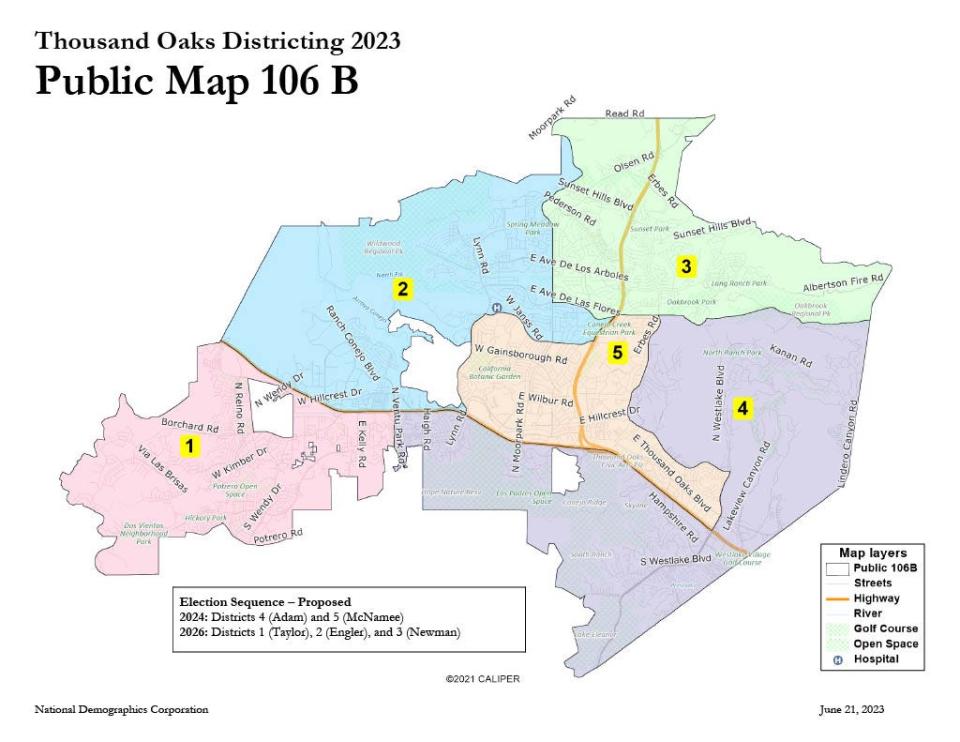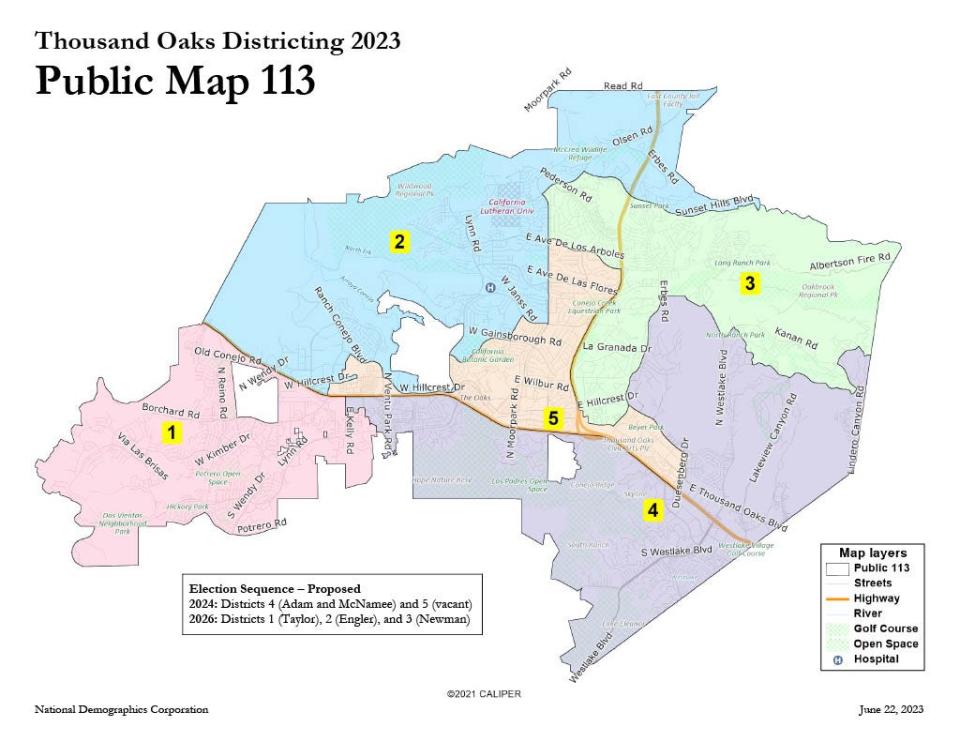Thousand Oaks adopts map for new City Council districts
Thousand Oaks is now the eighth Ventura County city to divide itself into districts for the purpose of City Council elections, after the council voted Tuesday night to adopt a district map that scores of residents urged it to reject.
Starting with the 2024 election, Thousand Oaks will be divided into five districts, leaving Fillmore and Port Hueneme as the only cities in Ventura County that elect all council members citywide. Two Thousand Oaks council seats will be on the ballot in 2024, and the other three will be up for election in 2026.
Like many cities and school districts that have recently adopted district elections, Thousand Oaks did so under the threat of a voting rights lawsuit. The California Voting Rights Act essentially requires district elections if at-large elections have failed to produce representatives from minority groups, and Thousand Oaks was facing legal action if it did not adopt district maps by July 24.
The district map approved by the Thousand Oaks City Council was not the one that most Thousand Oaks residents said they wanted. More than 30 people spoke before the council at its last two meetings and more than 100 submitted written comments, and virtually all of them urged the council to adopt what was referred to in the city’s process as Map 113. It was one of a handful of maps drawn by Chaise Rasheed, the Thousand Oaks resident who prompted the city to adopt districts by sending a legal demand letter in March.
Thousand Oaks residents who supported that map, and the two City Council members who spoke in favor of it at a July 11 council meeting, said it would do the best job in grouping “communities of interest” together into the same districts.
Their focus was on the new District 5, which every map under consideration placed in the center of the city, along Thousand Oaks Boulevard. With Rasheed’s map, they said, District 5 would have the best chance of electing the type of candidate who has never had much success in citywide elections: a Latino, a renter or someone from a lower-income household.
Instead, the City Council adopted Map 106B, which was first drawn by a local real estate agent and then revised by National Demographics Corp., the consulting firm the city hired to oversee the process. Council members who favored that map said it did the best job of drawing geographically compact districts, without what Councilman Mikey Taylor called “jagged boundaries,” and without stringing together neighborhoods in different areas of the city.

Keeping communities of interest and geographic neighborhoods together are both priorities for district boundaries under California law. Districts must also be contiguous, meaning every part of the district must be connected in some way to the rest of it; compact; and have easily identifiable boundaries. Federal law requires that districts have roughly equal populations, and race can’t be “the predominant factor” in drawing boundaries.
The District 5 in the map approved by the council is more compact than the one in Rasheed’s map, but less racially and economically diverse. On the map approved by the council, the district stretches east along Thousand Oaks Boulevard to include Westlake Hills, a relatively affluent neighborhood of single-family homes.
On the map drawn by Rasheed and supported by the people who spoke and wrote to the council, District 5 didn’t include Westlake Hills; instead, it extended west to include an area near the Amgen campus that has more apartment buildings.
In every map the council considered, District 5 had the lowest household income, the most renters and the most ethnic diversity. In the map approved by the council, 30% of District 5 residents are Latino, 49% are renters and 45% live in households with incomes under $75,000 per year, according to research by National Demographics Corp. With Map 113, the runner-up in the process, District 5 would have been 42% Latino and 56% renters, and 49% of households would have made less than $75,000 per year.

The City Council voted 4-1 on Tuesday to officially adopt Map 106B, with Councilman David Newman casting the dissenting vote. When the council discussed the matter at its previous meeting, Councilman Bob Engler also supported Map 113 over the eventual winner, but on Tuesday he voted with the majority to adopt Map 106B.
On July 11, when Map 113 didn’t get enough support to advance to a final vote, there was yelling and booing from the audience at City Hall, and cries of “shame, shame!” Mayor Kevin McNamee threatened to clear the room if people weren’t quiet, and someone responded by yelling, “Good, clear the room, including you!”
Some of the speakers said they thought the council chose Map 106B because it doesn’t require any of the incumbents to lose their posts; all five current council members live in separate districts on that map. With Map 113, NcNamee and Councilman Al Adam would have lived in the same district, so one of them would have had to move or lose his seat.
“Last week, I tried to explain to this council that many community members were fearful you were going to keep your old boys’ club in tact rather than serving the community, and I see you did just that,” Thousand Oaks resident Bonnie Shubb said at Tuesday’s meeting.
Council members on both sides of the mapping issue said that protecting incumbents was not a factor in the debate.
“That issue never came up with any council member,” Adam said, in an interview before Tuesday’s meeting. “No one brought it up. We weren’t looking at that at all. We were looking at satisfying the California and federal voting rights acts.”
Engler, who did not initially support the map approved by the council, said he thinks it still represents an improvement over the status quo of citywide elections.
“The big win here for folks who are looking for more representation is that we have gone to districts and the entire council embraced that,” he said. “The whole takeaway is that we have districts that will make it more available for more folks to be able to run.”
Editor's note: This article was updated to provide the correct name for Thousand Oaks resident Bonnie Shubb and to clarify that a local real estate agent drew the basis for the map adopted by the council.
Tony Biasotti is an investigative and watchdog reporter for the Ventura County Star. Reach him at tbiasotti@vcstar.com. This story was made possible by a grant from the Ventura County Community Foundation's Fund to Support Local Journalism.
This article originally appeared on Ventura County Star: Thousand Oaks adopts map for new City Council districts

